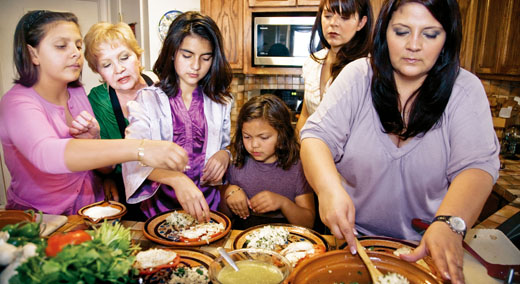Chicken Tikka Masala
Three generations of the Enriquez family—esteemed for their cooking—prepare dinner at their home in El Paso, Texas.
Thick tomato gravy makes a rich, creamy complement to juicy chicken with a hint of smoky flavor from the broiler; keeping the meat separate from the sauce until just before serving preserves its firm, succulent texture.
1 tbsp. ground turmeric
4 tsp. garam masala
1 tsp. red food coloring (optional)
6 cloves garlic, crushed
1 2½ -inch piece ginger, peeled and chopped, plus julienned strips for garnish
1 jalapeño, stemmed and chopped
1 28-oz. can whole peeled tomatoes, undrained
2 lbs. boneless, skinless chicken breasts, cut into
1½ -inch cubes
¼ cup plain Greek yogurt Kosher salt, to taste
6 tbsp. unsalted butter
1 tsp. coriander seeds
½ tsp. cumin seeds
1 tbsp. paprika
2 small yellow onions, minced
1 cup heavy cream Fresh cilantro leaves, for garnish
6 cups cooked basmati rice, for serving
Serves 6
1. In a blender, purée the turmeric, 2 tsp. garam masala, food coloring, garlic, ginger, jalapeños, and ½ cup water. Transfer the paste to a bowl. In the same blender, purée the tomatoes and strain through a sieve into a separate bowl; set aside.
2. In a bowl, mix 2 tbsp. of the reserved paste, along with the chicken cubes, yogurt, and salt; marinate for about 30 minutes. Place an oven rack 4 inches from the heating element; heat to broil. Transfer the chicken to a foil-lined baking sheet. Broil until cooked through, about 5 minutes; set aside.
3. Heat the butter in 6-qt. saucepan over medium-high heat. Add the coriander and cumin and toast for 4–6 minutes. Add the paprika and onions and cook until the onions are soft, 6–8 minutes. Add the remaining paste and brown for about 5 minutes. Add the tomatoes and cook for about 2 minutes. Stir in the cream and 1 cup water. Bring to a boil, then reduce the heat to medium-low and simmer until thickened, 6–8 minutes. Stir in the remaining garam masala and the broiled chicken; season with salt. Garnish with the julienned ginger and cilantro and serve over rice.
Special Sauce
The winning combination of succulent chicken and creamy, spice-laden tomato gravy known as chicken tikka masala has, over the years, become a comfort-food staple on Indian restaurant menus and in home kitchens around the world. Its beginnings are murky, though it likely originated in Great Britain in the 1970s, when an Indian restaurant cook attempted to replicate a famous Delhi restaurant’s signature dish, murgh makhani (butter chicken): tandoor-baked chicken in a sauce made with butter and tomatoes. Though some condemn the British riff on the dish, known as chicken tikka masala, as inauthentic (many recipes call for canned tomato soup, after all), I would argue that it belongs to a long and illustrious line of South Asian dishes that have been reinterpreted throughout the colonial and postcolonial eras, giving rise to a distinct, Anglo-Indian style of cookery. The dish’s main component, chicken tikka, or boneless chicken pieces marinated in a mixture of yogurt and spices and then cooked in a clay tandoor oven, is itself a classic Punjabi dish. The tandoor imparts a smoky flavor to the chicken, which acquires a vivid orange or scarlet hue from turmeric, cayenne, or, often, food coloring in the marinade. Today, many chefs opt for fresh tomatoes instead of tomato soup; some also enrich the sauce with ground almonds and substitute more-fragrant coconut milk for cream. Home cooks, too, have furthered the evolution by grilling or broiling the chicken to reproduce the tandoor-baked flavor. While the exact lineage of chicken tikka masala remains a subject of debate, I regard it with affection as an example of the dynamic nature of Indian food.
—Lizzie Collingham


